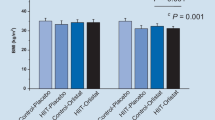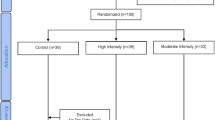Abstract
This study aimed to evaluate the effect and individual responsiveness after 12 weeks of high-intensity interval training (HIIT) and moderate-intensity of continuous training (MICT) on adiponectin, cardiometabolic risk factors and physical fitness in overweight adolescents. This study was participated by 52 adolescents, both sexes, 11 and 16 years old, separated into HIIT (n = 13), MICT (n = 15), and control group (CG, n = 24). Body mass, height, waist circumference (WC), fat mass (FM), fat-free mass (FFM), blood pressure, high-density lipoprotein (HDL-c), low-density lipoprotein (LDL-c), triglycerides, glucose, insulin, adiponectin, and C-reactive protein (CRP) were evaluated. Body mass index z-score (BMI-z), waist-to-height ratio (WHtR), insulin resistance, and insulin sensitivity were calculated. Resting heart rate (HRrest), peak oxygen consumption (VO2peak), right handgrip strength (HGS-right), left handgrip strength (HGS-left), and abdominal resistance (ABD) was evaluated. HIIT session lasted around 35 min and MICT of 60 min of exercises on stationary bicycle, three times a weekday for 12 weeks. ANOVA, effect size, and prevalence of responders were used for statistical analysis. HIIT reduced BMI-z, WHtR, LDL-c, and CRP, while increased of physical fitness. MICT reduced HDL-c, while increased of physical fitness. CG reduced FM, HDL-c, and CRP, while increased FFM and HRrest. Frequencies of respondents in HIIT were observed for CRP, VO2peak, HGS-right, and HGS-left. Frequencies of respondents in MICT were observed for CRP and HGS-right. Frequencies of no-respondents in CG were observed for WC, WHtR, CRP, HRrest, and ABD.
Conclusion: Interventions with exercises were effective to adiposity, metabolic health, and physical fitness improvements. Individual responses were observed in inflammatory process and physical fitness, important changes in overweight adolescent’s therapy.
Trial registration number and date of registration: This study was registered with the Brazilian Registry of Clinical Trials (REBEC), the number RBR-6343y7, date of registration May 3, 2017.
What is Known: • Effect of regular physical exercise positively affects overweight, comorbidities, and metabolic diseases, recommended mainly for children and adolescents. | |
What is New: • Due to the great inter-individual variability, the same stimulus can provide different responses; adolescents who benefit from the stimulus are considered responsive. • Intervention of HIIT and MICT did not alter the concentrations of adiponectin; however, the adolescents presented responsiveness to the inflammatory process and physical fitness. |


Similar content being viewed by others
Data availability
Data are available on request from the authors.
Abbreviations
- ABD:
-
Abdominal resistance
- APHV:
-
Age at peak height velocity
- BMI-z:
-
Body mass index z-score
- CG:
-
Control group
- CRP:
-
C-reactive protein
- DBP:
-
Diastolic blood pressure
- FM:
-
Fat mass
- FFM:
-
Fat-free mass
- HDL-c:
-
High-density lipoprotein cholesterol
- HGS-right:
-
Right handgrip strength
- HGS-left:
-
Left handgrip strength
- HIIT:
-
High-intensity interval training
- HOMA-IR:
-
Homeostasis model to assessment insulin resistance
- HRrest :
-
Resting heart rate
- LDL-c:
-
Low-density lipoprotein cholesterol
- MICT:
-
Moderate-intensity of continuous training
- PHV:
-
Peak height velocity
- QUICKI:
-
Quantitative insulin sensitivity check index
- SBP:
-
Systolic blood pressure
- TG:
-
Triglycerides
- VO2peak :
-
Peak oxygen consumption
- WC:
-
Waist circumference
- WHtR:
-
Waist-to-height ratio
References
World Health Organization (2020) WHO guidelines on physical activity and sedentary behaviour. World Health Organization, Geneva
García-Hermoso A, Ceballos-Ceballos RJM, Poblete-Aro CE, Hackney AC, Mota J, Ramírez-Vélez R (2017) Exercise, adipokines and pediatric obesity: a meta-analysis of randomized controlled trials. Int J Obes 41(4):475–482
García-Hermoso A, Ramírez-Campillo R, Izquierdo M (2019) Exercise, health outcomes, and pædiatric obesity: a systematic review of meta-analyses. J Sci Med Sport 22(1):76–84
Lopes WA, Leite N, Silva LR, Brunelli DT, Gáspari AF, Radominski RB et al (2016) Effects of 12wk of combined training without caloric restriction on inflammatory markers in overweight girls. J Sports Sci 34(20):1902–1912
Riebe D, Ehrman JK, Liguori G, Magal M (2018) American College of Sports Medicine (Eds.). ACSM’s guidelines for exercise testing and prescription. Wolters Kluwer
Keating SE, Machan EA, O’Connor ET, Gerofi JA, Sainsbury A et al (2014) Continuous exercise but not high intensity interval training improves fat distribution in overweight adults. J Obes 2014:834865
Ramos JS, Dalleck LC, Tjonna AE, Beetham KS, Coombes JS (2015) The impact of high-intensity interval training versus moderate-intensity continuous training on vascular function: a systematic review and meta-analysis. Sports Med 45:679–692
Bonafiglia JT, Rotundo MP, Whittall JP, Scribbans TD, Graham RB, Gurd BJ (2016) Inter-individual variability in the adaptive responses to endurance and sprint interval training: a randomized crossover study. PLoS ONE 11(12):e0167790
Álvarez C, Ramírez-Campillo R, Ramírez-Vélez R, Izquierdo M (2017) Effects of 6-weeks high-intensity interval training in schoolchildren with insulin resistance: influence of biological maturation on metabolic, body composition, cardiovascular and performance non-responses. Front Physiol 29(8):444
Álvarez C, Ramírez-Campillo R, Ramírez-Vélez R, Martínez C, Castro-Sepúlveda M, Alonso-Martínez A, Izquierdo M (2017) Metabolic effects of resistance or high-intensity interval training among glycemic control-nonresponsive children with insulin resistance. Int J Obes 42(1):79–87
Brand C, Martins CMDL, Lemes VB, Pessoa MLF, Dias AF, Cadore EL et al (2020) Effects and prevalence of responders after a multicomponent intervention on cardiometabolic risk factors in children and adolescents with overweight/obesity: Action for health study. J Sports Sci 38(6):682–691
Leite N, Tadiotto MC, Corazza PRP, Menezes Junior FJ, Carli MEC, Milano-Gai GE et al (2021) Responsiveness on metabolic syndrome criteria and hepatic parameters after 12 weeks and 24 weeks of multidisciplinary intervention in overweight adolescents. J Endocrinol Invest 45(4):741–752
Onis M, Onyango AW, Borghi E, Siyam A, Nishida C, Siekmann J (2007) Development of a WHO growth reference for school-aged children and adolescents. Bull World Health Organ 85:660–667
Moore SA, McKay HA, MacDonald H, Nettlefold L, Baxter-Jones AD, Cameron N et al (2015) Enhancing a somatic maturity prediction model. Med Sci Sports Exerc 47(8):1755–1764
Houtkooper LB, Going SB, Lohman TG, Roche AF, Van Loan M (1992) Bioelectrical impedance estimation of fat-free body mass in children and youth: a cross-validation study. J Appl Physiol 72(1):366–373
Matthews DR, Hosker JP, Rudenski AS, Naylor BA, Treacher DF, Turner RC (1985) Homeostasis model assessment: insulin resistance and beta-cell function from fasting plasma glucose and insulin concentrations in man. Diabetologia 28(7):412–419
Katz A, Nambi SS, Mather K, Baron AD, Follmann DA, Sullivan G, Quon MJ (2000) Quantitative insulin sensitivity check index: a simple, accurate method for assessing insulin sensitivity in humans. J Clin Endocrinol Metab 85(7):2402–2410
Plowman SA, Meredith MD (2013) Fitnessgram/Activitygram reference guide. Dallas Cooper Institute
Hopkins WG (2007) A spreadsheet for deriving a confidence interval, mechanistic inference and clinical inference from a P value. Sportscience 11:16–21
García-Hermoso A, Ramírez-Vélez R, Ramírez-Campillo R, Peterson MD, Martínez-Vizcaíno V (2018) Concurrent aerobic plus resistance exercise versus aerobic exercise alone to improve health outcomes in paediatric obesity: a systematic review and meta-analysis. Br J Sports Med 52(3):161–166
Borfe L, Brand C, Schneiders LB, Mota J, Cavaglieri CR, Leite N et al (2021) Effects and responsiveness of a multicomponent intervention on body composition, physical fitness, and leptin in overweight/obese adolescents. Int J Environ Res Public Health 18(14):7267–7281
Yu N, Ruan Y, Gao X (2017) Sun J (2017) Systematic review and meta-analysis of randomized, controlled trials on the effect of exercise on serum leptin and adiponectin in overweight and obese individuals. Horm Metab Res 49(3):164–173
Nascimento H, Costa E, Rocha S, Lucena C, Rocha-Pereira P, Rêgo C et al (2014) Adiponectin and markers of metabolic syndrome in obese children and adolescents: impact of 8-mo regular physical exercise program. Pediatr Res 76(2):159–165
Park TG, Hong HR, Lee J, Kang HS (2007) Lifestyle plus exercise intervention improves metabolic syndrome markers without change in adiponectin in obese girls. Ann Nutr Metab 51(3):197–203
Borges MC, Oliveira IO, Freitas DF, Horta BL, Ong KK, Gigante DP, Barros AJD (2017) Obesity-induced hypoadiponectinemia: the opposite influences of central and peripheral fat compartments. Int J Epidemiol 46(6):2044–2055
Shakiba E, Sheikholeslami-Vatani D, Rostamzadeh N, Karim H (2019) The type of training program affects appetite-regulating hormones and body weight in overweight sedentary men. Appl Physiol Nutr Metab 44(3):282–287
Fasshauer M, Kralischa S, Klier M, Lossner U, Bluher M, Klein J, Paschke R (2003) Adiponectin gene expression and secretion is inhibited by interleukin-6 in 3T3-L1 adipocytes. Biochem Biophys Res Commun 301(4):1045–1050
Briones AM, Aras-López R, Alonso MJ, Salaices M (2014) Small artery remodeling in obesity and insulin resistance. Curr Vasc Pharmacol 12(3):427–437
Emken BA, Richey J, Belcher B, Hsu YW, Spruijt-Metz D (2010) Objectively measured physical activity is negatively associated with plasma adiponectin levels in minority female youth. Int J Pediatr Endocrinol 2010:846070
Nielsen MS, Quist JS, Chaput JP, Dalskov SM, Damsgaard CT, Ritz C et al (2016) Physical activity, sedentary time, and sleep and the association with inflammatory markers and adiponectin in 8-to 11-year-old Danish children. J Phys Act Health 13(6):733–739
Liu Y, Sweeney G (2014) Adiponectin action in skeletal muscle. Best Pract Res Clin Endocrinol Metab 28(1):33–41
Xu A, Sweeney G (2015) Emerging role of autophagy in mediating widespread actions of ADIPOQ/adiponectin. Autophagy 11(4):723–724
Turer AT, Scherer PE (2012) Adiponectin: mechanistic insights and clinical implications. Diabetologia 55(9):2319–2326
Ciccone MM, Faienza MF, Altomare M, Nacci C, Montagnani M, Valente F et al (2016) Endothelial and metabolic function interactions in overweight/obese children. J Atheroscler Thromb 23(8):950–959
Funding
Study was financed by Fundação Araucária-PR/SESA-PR/Conselho Nacional de Desenvolvimento Científico e Tecnológico (CNPq)/MS-Decit-PPSUS. Study was financed in part by Coordenação de Aperfeiçoamento de Pessoal de Nível Superior (CAPES) — Finance Code 001. MCT was supported by CNPq — Postdoctoral. NL was supported by CNPq — Research Productivity.
Author information
Authors and Affiliations
Contributions
The manuscript was written by MCT and NL, as well as reviewers PRPC, FJMJ, FBMJ, TAAT, KSMP, JM, and NL. Concept and design: MCT, PRPC, FJMJ, FBMJ, TAAT, KSMP, and NL. Methodology: MCT, PRPC, FJMJ, FBMJ, KSMP, and NL. Data acquisition: MCT, PRPC, and NL. Supervision: KSMP and NL. Data analysis and interpretation: MCT and NL. All approved the final version to be submitted.
Corresponding author
Ethics declarations
Ethics approval
The study was performed in line with the principles of the Helsinki Declaration. The study protocol has been approved by the Research Ethics Committee of the UniDBSCO University Center — Brazil (no. 1.990.654, CAAE 62963916.0.0000.5223/2017).
Consent to participate
Parents and/or guardians and adolescents were informed of the procedures of the study, and all provided written informed consent.
Consent for publication
Not applied.
Conflict of interest
The authors declare no competing interests.
Additional information
Communicated by Peter de Winter.
Publisher's Note
Springer Nature remains neutral with regard to jurisdictional claims in published maps and institutional affiliations.
Rights and permissions
Springer Nature or its licensor (e.g. a society or other partner) holds exclusive rights to this article under a publishing agreement with the author(s) or other rightsholder(s); author self-archiving of the accepted manuscript version of this article is solely governed by the terms of such publishing agreement and applicable law.
About this article
Cite this article
Tadiotto, M.C., Corazza, P.R.P., Menezes-Junior, F.J. et al. Effects and individual response of continuous and interval training on adiponectin concentration, cardiometabolic risk factors, and physical fitness in overweight adolescents. Eur J Pediatr 182, 2881–2889 (2023). https://doi.org/10.1007/s00431-023-04974-6
Received:
Revised:
Accepted:
Published:
Issue Date:
DOI: https://doi.org/10.1007/s00431-023-04974-6




